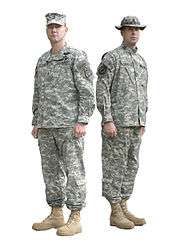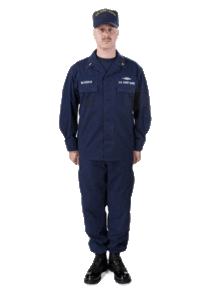Uniforms of the United States Armed Forces

A U.S. Armed Forces Joint Ceremony at the D.C. National Guard Armory in April 2008
Each branch of the United States Armed Forces has their own uniforms and regulations regarding them.
- Uniforms of the United States Army
- Uniforms of the United States Marine Corps
- Uniforms of the United States Navy
- Uniforms of the United States Air Force
- Uniforms of the United States Coast Guard
Combat uniforms overview

 Marine Corps - MCCUU
Marine Corps - MCCUU
(woodland and desert variants)_Type_III.jpg) Navy - NWU
Navy - NWU Air Force - ABU
Air Force - ABU Coast Guard - ODU
Coast Guard - ODU Coast Guard - CGCUU (used in oversea deployment or combat operations)
Coast Guard - CGCUU (used in oversea deployment or combat operations) Other - MultiCam, used by U.S. Army and ground U.S. Air Force units deployed in Afghanistan, and Special Operations Forces.
Other - MultiCam, used by U.S. Army and ground U.S. Air Force units deployed in Afghanistan, and Special Operations Forces.
Service dress uniforms overview
Current camouflage patterns
| List of current camouflage patterns and uniforms | |||||
|---|---|---|---|---|---|
| Branch | Camouflage pattern | Image | Notes | In use since | |
U.S. Army |
Universal Camouflage Pattern, used for the Army Combat Uniform (ACU). Units deployed in Afghanistan use MultiCam instead, known as OEFCP (Operation Enduring Freedom Camouflage Pattern). As of 2015, Scorpion W2 (designated OCP), a variant of Multicam, is now the main issued camouflage pattern for U.S. Army units. |
and  |
On June 16, 2009, the United States House of Representatives passed a bill requiring the Army to buy new, different uniforms for the War in Afghanistan, with camouflage pattern that would better suit the Afghan environment.[1] As of 2010, U.S. Army units deployed in Afghanistan are being issued uniforms with MultiCam pattern. This was further exemplified in 2015, with the U.S. Army beginning to fully adopt the Scorpion W2 camouflage pattern (which is very similar to Multicam) as the main camouflage for it's units. UCP will be completely phased out with U.S. Army units by 2019. Units such as the 75th Ranger Regiment who had already widely adapted Multicam by then, will continue to use the pattern into the foreseeable future due to its vast similarities to Scorpion W2. | UCP: 2005–
Multicam (Including Scorpion W2): 2010– | |
U.S. Marine Corps |
MARPAT pattern, used for the Marine Corps Combat Utility Uniform (MCCUU) in two variants, woodland and desert. |   |
The USMC's MARPAT pattern was the first digitalized (pixelated) pattern in the U.S. military, unveiled in mid-2001.[2][3][4] It was first available in January 2002 and was mandatory by late 2004.[5][6] | 2002- | |
U.S. Navy |
Navy Working Uniform (NWU). |  |
There are three variants of the camouflage. Type I standard blue-grey intended to be the standard shipboard and ashore working uniform for all Navy personnel but subsequently disapproved for shipboard wear due to lack of flame resistance (unveiled in October 2004, in 2016 it was announced the uniform would be discontinued as of 1 October 2016 with wear not authorized after 1 October 2019); Type II desert variant authorized only for Naval Special Warfare units in desert environments; Type III woodland variant, initially authorized only for specific land based units but subsequently announced as the standard ashore working uniform for all Navy personnel effective 1 October 2016. Type II and III are similar in hue to MARPAT. | 2009 | |
U.S. Air Force |
Digitalized tigerstripe, used for the Airman Battle Uniform (ABU). Air Force ground-based units, security units, and special operations units, that are deployed in Afghanistan, use MultiCam instead, known as OCP pattern. |
and  |
Fielding of MultiCam began in September 2010. | 2007 | |
See also
- I. Spiewak & Sons, manufacturers of apparel for US Army, US Navy, and US Airforce during World War I, World War II, and Korean war
References
- ↑ Maze, Rick (June 15, 2009). "Troops in Afghanistan would get new uniforms". Army Times. Gannett Government Media. Retrieved November 26, 2013.
Congress is about to order new combat uniforms for troops in Afghanistan after hearing complaints that camouflage that was fine in Iraq doesn't work so well in a mountainous and often muddy environment.
- ↑ Jontz, Sandra (February 24, 2001). "Marines' followed Canadians' example in use of digitally-designed 'cammies'". Stars and Stripes. Archived from the original on June 6, 2002. Retrieved June 6, 2002.
- ↑ Starr, Barbara (June 20, 2001). "From Cammies to Pixies?: Marines Dump Old Wrinkled Duds for Permanent Press and Pixel Patterns". ABC News. ABC News Internet Ventures. Archived from the original on June 25, 2001. Retrieved June 25, 2001.
- ↑ Oliva, Mark; Childs, Jan Wesner (July 3, 2001). "Officials went to the source to ensure new Marine uniform pleased troops". Stars and Stripes. Archived from the original on July 25, 2001. Retrieved July 25, 2001.
- ↑ United States Marine Corps. "U.S. Marines Combat Utility Uniforms 2003" (PDF). United States Department of the Navy. United States Department of Defense. Archived from the original (PDF) on April 9, 2008. Retrieved April 9, 2008.
The woodland pattern combat utility uniform was first made available to selected commands on 17 January 2002.
- ↑ "New uniform debuts today". Around the Fleet. Marine Corps Base Quantico, Virginia. January 17, 2002. Retrieved September 19, 2013.
This article is issued from Wikipedia - version of the 11/21/2016. The text is available under the Creative Commons Attribution/Share Alike but additional terms may apply for the media files.


._The_SU_is_for_year-round_wear_and_replaces_summer_white_and_winter_blue_uniforms.jpg)

